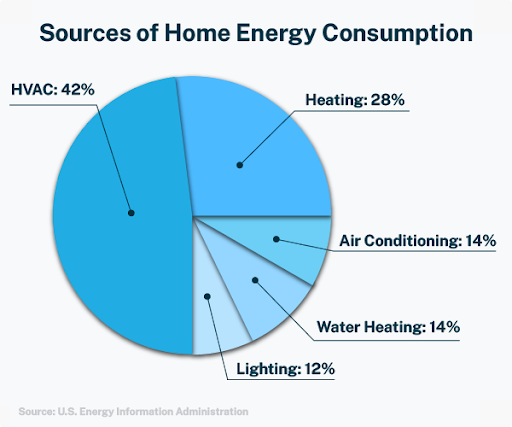Chicago Illinois Home Energy Statistics

Understanding how energy consumption plays out on a state level can help every Illinois homeowner better manage their energy expenses. Generally, the cost of energy across the state is influenced by multiple factors such as personal energy needs, individual household lifestyle, and Illinois’ varying weather conditions.
Here are a couple of Quick Energy Facts about Illinois.
- Ranked 22nd as the highest producer of energy per capita in the country, the state of Illinois generates about 14.42 megawatt hours per capita per year from its power plants.
- Illinois produces 21,401,545.68 megawatt hours of electricity from sustainable fuel types. This ranks Illinois 9th in the country for total renewable electricity generation.
- Of all US States, Illinois is 5th in megawatt hours produced from wind power.
How does Illinois’ energy consumption compare to other states? Illinois is a deregulated electricity market state. This means that–instead of being forced to buy their energy from a single electricity company–consumers are free to purchase their electricity from the many independent retail electricity providers (REPs) that serve the state.
Here are some important energy statistics about Illinois:
- The state of Illinois is the 5th largest energy consumer in the US—with the industrial sector (agriculture, coal mining, and petroleum refining) accounting for the largest energy consumption at 31.3%.
- Illinois’ total energy consumption per capita is on par with the national average, despite the state’s relatively great climate condition throughout the year.
- Due to its strategic location and robust transportation system, Illinois contributes significantly to the national economy. The vast transportation network makes it the second largest sector to consume energy in the state.
- Energy use in the residential segment is marginally lower than in the transportation sector.
How much energy does the average Illinois home consume?
The average Illinois home uses about 721 kWh every month, which drives the collective Illinois residential sector to account for about 26% of Illinois’ total energy usage. As such, Illinois is among the lowest-ranking states in terms of total energy use and expenditure per capita.
How much do Illinois residents pay for energy?
In 2019, Illinois ranked 42nd out of the 50 states, with the total energy expenses per capita at around $3,367.
If you yourself want to calculate your household’s total energy bill for a year, you can do so quite easily. Simply multiply your average monthly consumption by the rate per kWh in your area. Then multiply the product by 12 months to get the total annual amount.
What is the average home electricity bill in Chicago?
Residential owners in Chicago have an average monthly electricity bill of $124.24, relatively higher than the US-wide average of $118.93. This is based on the city’s average residential electricity rate of 14.85 cents per kilowatt hour; that’s 6.14% higher than the average US price of 13.99 cents.
Where does Chicago get its energy from?
The state of Illinois is served by two regional grid systems namely the PJM Interconnection and Midcontinent Independent System Operator (MISO). The Metropolises surrounding Chicago–along with the state’s Northern and Mid-Atlantic regions–all get their electricity from PJM Interconnection’s wholesale power source.
Chicago and Illinois in general gets its energy from a good mix of energy sources. The state is mainly powered by natural gas, nuclear, biofuels, coal, and solar power plants; respectively.
What is the average gas bill in Chicago?
Residents of Chicago, Illinois have an average natural gas bill of $76 a month. Based on a $60.34 national average, Illinois has the 10th highest monthly bill, out of the 52 states and territories across the US,
What are the biggest sources of home energy consumption in Chicago, Illinois?
Illinois’ residential sector takes about 22.8%-26% of the state’s total end-use power consumption—making it the third largest sector to utilize energy for residential purposes. The same is true with US homes, which also ranks third in energy consumption by sector.
Energy statistics show that in 2020 alone, about 10,715 kilowatt hours of energy is spent yearly by a typical US household. This amount leads to an average monthly consumption of 893 kWh per residential unit.
U.S. homes generally use 65% of its residential energy for room heating and cooling, while another 14% is used for water heating. With improved home insulation, windows, and appliances, an average American household has tremendously decreased its overall energy consumption over the course of time.
Here is a breakdown of energy usage the usual home appliances every US household have in common:

How to improve the energy efficiency of your home in Chicago, Illinois?
Although a sizable portion of energy is used for heating and cooling, there are other ways on how to efficiently use energy and make your home more environmentally-friendly. Energy-efficient cooling and heating systems help reduce your monthly energy consumption, therefore providing you with bigger energy cost savings.
Nowadays, energy-efficient air conditioning units as well as highly efficient furnaces are available in the market. New air conditioners now have advanced compressor technology, making it more dependable and efficient. Modern furnaces installation also have improved build and quality, giving every home a long lasting heating system.
With the exponential increase of energy consumption across the world, the local government of Chicago encourages homeowners to consider green energy solutions when getting their electricity.


